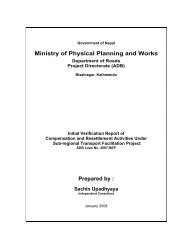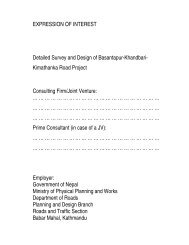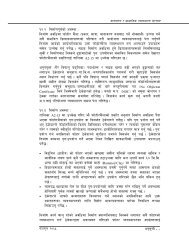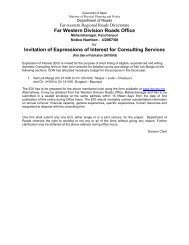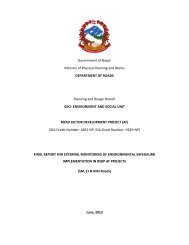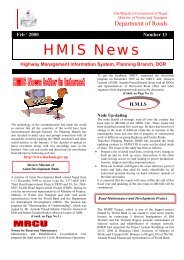Environmental & Social Management Framework - About ...
Environmental & Social Management Framework - About ...
Environmental & Social Management Framework - About ...
You also want an ePaper? Increase the reach of your titles
YUMPU automatically turns print PDFs into web optimized ePapers that Google loves.
<strong>Environmental</strong> & <strong>Social</strong> <strong>Management</strong> <strong>Framework</strong>result, the Unit has failed to retain experts trained in social and environmentalfields.10.5 Recommendations for Upgrading the Institutional Capacity of theGESUThe existing weaknesses in the ability to implement adequate environmental andsocial safeguards for road projects are caused by a combination of weaktechnical and resource capacity, low morale, inadequate enforcement andmonitoring. However, these all stem from inappropriate institutional arrangementsbetween the many institutions currently involved in these important functions.Unless these external weaknesses are addressed adequately, the DoR’s GESUwill be unable to carry out its functions properly, regardless of its internalcapacity.These recommendations therefore address constraints that are external to theGESU (institutional recommendations), and constraints internal to the GESU(organisational recommendations).10.5.1 Develop Standardized ProceduresClarity is required in the roles, responsibilities and hence functions for each of theinstitutions involved in the development, implementation and enforcement ofenvironmental and social functions associated with road projects in Nepal. Suchclarity is necessary if these institutions are to fulfil their functions efficiently,without duplication with other institutions. It will also make the purpose ofreporting much clearer and make monitoring, auditing and problem identificationmuch more straightforward. Most importantly, all of these benefits should alsoresult in a far more effective implementation and enforcement of appropriateenvironmental and social policies and standards. At present, such institutionalclarity and clearly defined mandates are lacking, with the result that decisionmaking is slow, cumbersome and bureaucratic; problems are difficult to identify(and hence rectify); and accountability, reporting and auditing weak.The following set of recommendations is made to overcome these existinginstitutional weaknesses:(1) <strong>Environmental</strong>/social and internal standard regulations should beestablished clearly by the Ministry for the Environment. These should beclear and include detailed project preparation, supervision and reportingrequirements (defined in terms of what information is to be provided, nothow the work is to be carried out, which should be the responsibility of theimplementing agency, i.e. the GESU and DoR).(2) Standards need to be elaborated that should stipulate study and surveymechanisms related to the environmental and social assessmentactivities, such as techniques for baseline information, methods formeasuring standard (and really required) bio-physical and socialparameters, formalization of household surveys, monitoring indicators andverification techniques, compliance control and enforcement,compensation requirements, and public consultation processes, grievanceprocedures, audit procedures,(3) In establishing appropriate policies and standards, the MoEST shoulddiscuss what measures should be included from the Department ofForestry and Department of Archaeology. However, responsibility for thisfunction should ultimately rest with the MoEST who should ensure that theresulting policies and standards are consistent and realistic. Note thatChapter 10-8 April 2007



![j:6 ]zg cfof ]hgf](https://img.yumpu.com/51286794/1/190x245/j6-zg-cfof-hgf.jpg?quality=85)

![x'nfsL /fhdfu { cfof ]hgf](https://img.yumpu.com/50581959/1/190x245/xnfsl-fhdfu-cfof-hgf.jpg?quality=85)
